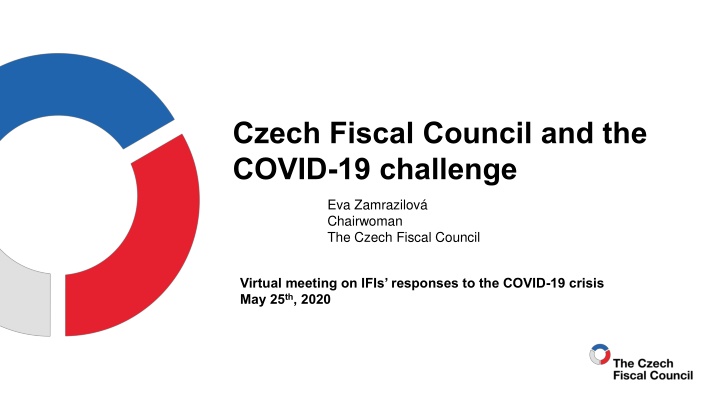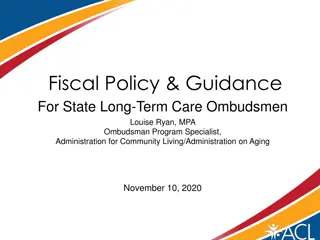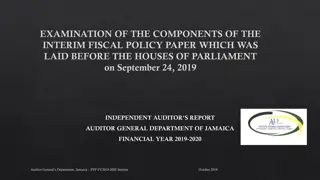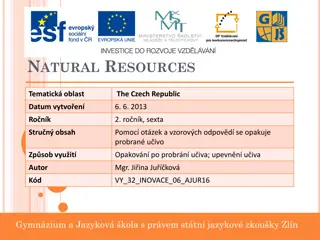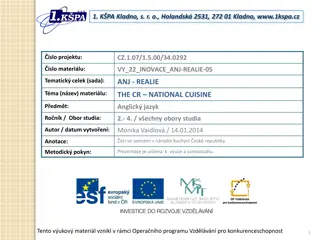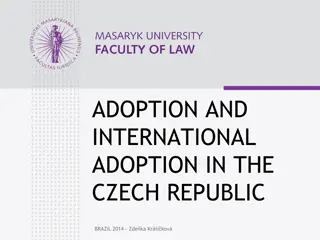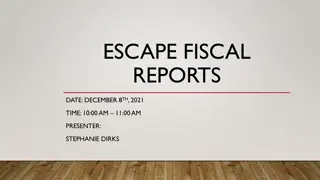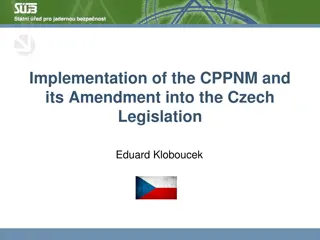Czech Fiscal Council and the COVID-19 challenge
Learn about the insights shared by Eva Zamrazilova, Chairwoman of the Czech Fiscal Council, during a virtual meeting discussing the responses of International Financial Institutions to the COVID-19 crisis on May 25th, 2020. Gain valuable perspectives on navigating this unprecedented situation and the strategies being implemented.
Download Presentation

Please find below an Image/Link to download the presentation.
The content on the website is provided AS IS for your information and personal use only. It may not be sold, licensed, or shared on other websites without obtaining consent from the author.If you encounter any issues during the download, it is possible that the publisher has removed the file from their server.
You are allowed to download the files provided on this website for personal or commercial use, subject to the condition that they are used lawfully. All files are the property of their respective owners.
The content on the website is provided AS IS for your information and personal use only. It may not be sold, licensed, or shared on other websites without obtaining consent from the author.
E N D
Presentation Transcript
Czech Fiscal Council and the COVID-19 challenge Eva Zamrazilov Chairwoman The Czech Fiscal Council Virtual meeting on IFIs responses to the COVID-19 crisis May 25th, 2020
The Czech public debt is relatively low; however, not risk-free 2000.0 50.0 1800.0 45.0 1600.0 40.0 1400.0 35.0 1200.0 30.0 1000.0 25.0 800.0 20.0 600.0 15.0 400.0 10.0 200.0 5.0 0.0 0.0 Public debt held by residents, CZK bill. Public debt held by non-residents, CZK bill. Public debt (% GDP)- right axis Source: CNB, ARAD At the end of 2019 foreign subjects held almost 40 % of government debt safe level at 35 % (CNB) foreign investors are more sensitive than domestic ones As for domestic holders, banks have been among the most important, with government bonds representing 15 % of bank assets in 2015 criticized by CNB in FSRs (declined to 7 % in 2019, eop) Risk of sovereign concentration (sovereign-bank nexus) thus declined; however, replaced by potential risk of investor sentiment spillovers from abroad Average duration to maturity of government debt declined from 6.2 years (2019 year-end) to 5 years (end of March 2020) S2 indicator increased from 4.1 (2018) to 4.8 (2019) and remains one of the highest among EU 27 Report on the Long-Term Sustainability of Public Finances 2018 and Report on the Long-Term Sustainability of Public Finances 2019 2
The costs of the COVID-19 pandemic 300 250 Loss in CZK bill. 200 150 100 50 0 0 -1 -2 -3 -4 -5 -6 -7 -8 -9 -10 GDP balance in % Value added tax Consumer taxes Corporate income tax Personal income tax Health insurance Social insurance Source: CFC The state budget 2020 plans a CZK 300 bill. deficit, roughly 5.5 % of GDP (end of May 2020) This estimate may not be final as the GDP decline in both real/nominal terms is subject to strong uncertainty The extra (discretion) expenditures are now estimated to exceed CZK 150 bill. (3 % of GDP) and cover mostly: Childcare benefit for parents who are employed or self-employed (prolonged until end of June! even for parents whose children may return to school/pre-school) Wage compensation for companies (limitation of operation and quarantine) Compensation bonuses for small entrepreneurs Study Fiscal Costs of the COVID-19 Pandemic in the Czech Republic & Updated estimate situation as at 5 May 2020 Income loss estimated between CZK 150 250 bill. (3 5 % of GDP) The dividing line between income loss and extra expenditure will be clearer at the end of the year Measures on the income side seem to be more efficient than direct expenditure It is not easy to deliver money directly into the economy if help is to be targeted (bearing in mind resources are limited) At the same time it is difficult to distinguish between the complaints of free-riders and the victims of bureaucracy 3
Budget Responsibility Act: adopted January 2017 - amended May 2020 The Budget Responsibility Act should have been a Constitutional law according to the original plans from 2012 Two basic insurance tools fiscal rules Limit on total public sector expenditures (E) based on 1 % structural deficit Limit on public debt (adjusted for Treasury reserves) 55 % of GDP Hitting this limit should be automatically followed by an adoption of measures leading to stabilization (the government should approve and submit a new stabilizing budget) Escape clauses Status of war, emergency or similar threats Strong deterioration of economic conditions (2 % q/q or 3% y/y decline of GDP) May 2020 amendment to Budget Responsibility Act essence Increase in the limit for expenditures for the next 7 years (2021-2027) 2021 Structural deficit rule set to 4 %, 2022 (3.5 %), 2023 (3 %), 2024 (2.5 %), 2025 (2 %), 2026 (1.5 %), 2027 (back to 1 %) May 2020 amendment to Budget Responsibility Act procedure Not discussed with CFC, adopted by the government during the state of legislative emergency (simplified process of passing laws) The CFC s statement nonetheless requested by the Senate (hearings first at Committee on the Economy, Agriculture and Transport, then the plenary meeting of the Senate) Senate rejected the amendment (out of 40 senators 33 against, 3 in favor, 4 abstained) Opposition parties requested the CFC s statement, hearing in the Chamber of Deputies Chamber of Deputies adopted the law by a tight majority of 101 (at least 101 votes were necessary for outvoting the Senate rejection) The risk of the debt brake shift under unfavourable macroeconomic conditions in the future 4
7-year outlook: original law and new law 50 Comparison with previous crisis 40 50.0 30 45.0 43.7 20 40.0 10 35.0 0 30.0 -10 2019 2020 2021 2022 2023 2024 2025 2026 2027 25.0 20.0 Structural saldo (% of GDP), "new law" 0 1 2 3 4 5 6 7 8 Structural saldo (% of GDP), "original law" Period 2019-2027 "new law" Period 2008-2016 Public debt (% of GDP), "new law" Period 2019-2027 "original law" Public debt (% of GDP), "original law" Source: MoF, CFC Source: MoF, CFC COVID-19 will necessarily push the debt/GDP trajectory up - the CFC supports the fiscal stimulus efforts for 2020 However, the consolidation should start ASAP Under the original domestic law the debt trajectory would have been pushed up by approximately 10 pp in the 7-year outlook in comparison with the original CFC long-term projection from June 2019 Under the new law the trajectory will be pushed up by more than 20 pp in the 7-year outlook in comparison with the original CFC long-term projection from June 2019 A deterioration of the cost of ageing component of the S2 sustainability indicator caused the tightening of the Medium-Term Budgetary Objective (MTO) to 0.75 % GDP as of 2020 (not considered in the slides) As the criterion reached 0.53, MTO was close to even a tighter limit (-0.5 % GDP) With no policy change, MTO will be tighter in the future domestic law has been softer than the European legislation 5
The uncertainties backstage Output gap estimates under old and new methodology Structural balance estimate: January 2020 and April 2020 3.6 4.0 2.6 2.5 3.0 1.5 1.7 2.0 1.0 1.0 0.5 0 0.0 0.0 -0.5 -1.0 -0.5 -0.6 -1 -1.0 -2.0 -1.4 -1.9 -1.5 -3.0 -2.0 -3.3 -4.0 -4.1 -2.5 -5.0 2011 2012 2013 2014 2015 2016 2017 2018 2019f 2020f 2018 2019 2020 2021 2022 2023 Structural saldo: January 2020 Structural saldo: April 2020 OG: April 2020 (new methodology) OG: April 2020 (old methodology) Source: Ministry of Finance Source: Ministry of Finance Estimate of the potential product (PP) and the output gap (OG) for budgetary planning has changed considerably between January and April in the MoF forecast OG estimate changes have resulted in differences in the estimates of structural balance rewriting the history The output gap (OG) estimate is known to be sensitive to the end point bias ; however, a change of methodology has played some role as well (right hand panel) Tuning the methodology is a subject of further concern, discussions, and efforts, as the methodology should be a joint product of the Ministry of Finance and the Czech Fiscal Council (April change was not discussed with CFC) The end point bias impact should be mitigated to make the estimates of PP and OG more robust to strong cyclical fluctuations 6
Public finance topics in the media 1800 1600 1400 1200 1000 800 600 400 200 0 Budget deficit Public debt Public finance Czech Fiscal Council JAN & FEB 2020 MAR & APR 2020 Source: Media monitoring Czech media more interested in public finance topics during the coronavirus pandemic In March and April 2020 up to 5.5 times more articles & TV/radio broadcasts about public finance topics than in January and February Number of articles containing the words Czech Fiscal Council almost doubled Data exclude social media (esp. twitter), which are also an important channel of communication 7
CFC Messages CFC feels very uneasy about the amendment to the Budget Responsibility Act As for the formal procedure the rule was softened for 7 years in the state of legislative emergency, immediately after the first economic disturbance, merely 3 years after the adoption of the Law As for its negative impact on the long-term sustainability of public finances (CFC is currently finishing its 3rd Report on the Long-Term Sustainability of Public Finances) Mid-term challenge: address the pro-cyclicality of fiscal policy stabilization function The question arises whether the current methods backstage of fiscal rules (potential product and output gap estimates) are sufficiently robust and do not support pro-cyclicality of fiscal policy? Joint efforts with the Ministry of Finance are necessary to make the methodology completely transparent and open to the public In the long run the pension system is the main issue which should not be forgotten due to the present crisis every crisis will come to an end, but ageing of population will continue CFC is very much looking forward to OECD proposals for the pension reform hopefully coming in July 8
Thank you eva.zamrazilova@unrr.cz
